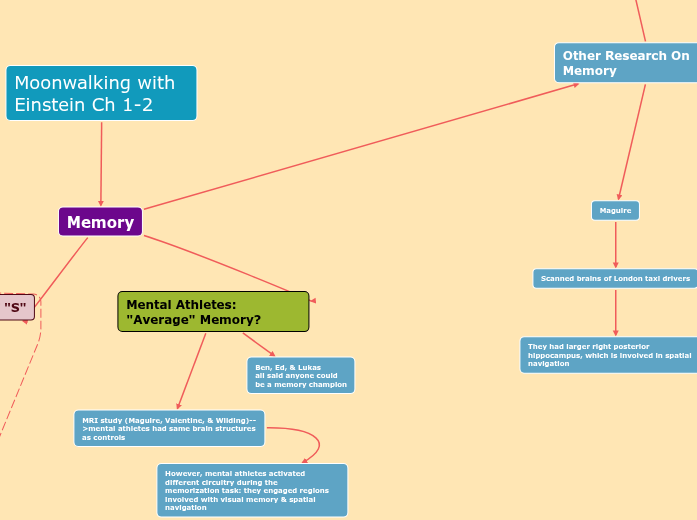Moonwalking with Einstein Ch 1-2
Memory
The Special Case of "S"
Synesthesia: hearing/reading words/
numbers conjured up images, sounds, tastes, textures
"Take the number 1. This is a proud, well-built man; 2 is a high-spirited woman; 3 a gloomy person (why, I don't know); 6 a man with a swollen foot; 7 a man with a mustache; 8 a very stout woman--a sack within a sack"(Foer, 2011, p. 33).
Drawbacks
Trouble understanding abstract
concepts & metaphors b/c of
all the images (Foer, 2011, p. 33).
Unable to distinguish between
useless & useful material; can't
prioritize or generalize;
unemployable (Foer, 2011, p. 36).
Mental Athletes: "Average" Memory?
MRI study (Maguire, Valentine, & Wilding)-->mental athletes had same brain structures as controls
However, mental athletes activated
different circuitry during the
memorization task: they engaged regions involved with visual memory & spatial
navigation
Ben, Ed, & Lukas
all said anyone could
be a memory champion
Other Research On Memory

Ebbinghaus
Single-subject study on himself using nonsense syllables produced curve of
forgetting
Maguire
Scanned brains of London taxi drivers
They had larger right posterior hippocampus, which is involved in spatial navigation
The brain is a mutable organ: neuroplasticity (Foer, 2011, p. 38).
Baker/baker paradox
When shown faces, people are more likely
to remember that the person is a baker
rather than their last name is Baker
Knowing someone's profession provides many more neural links than does a proper noun
References
Foer, J. (2011). Moonwalking with Einstein: The art and science of remembering everything. New York, NY: Penguin Books.
